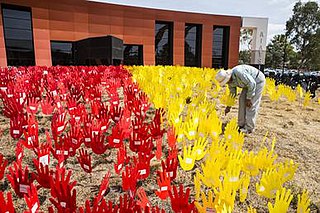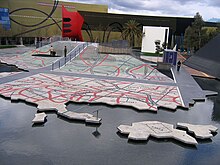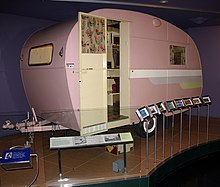The Melbourne Museum is a natural and cultural history museum located in the Carlton Gardens in Melbourne, Australia.

The National Gallery of Australia (NGA), formerly the Australian National Gallery, is the national art museum of Australia as well as one of the largest art museums in Australia, holding more than 166,000 works of art. Located in Canberra in the Australian Capital Territory, it was established in 1967 by the Australian Government as a national public art museum. As of 2022 it is under the directorship of Nick Mitzevich.

Indigenous Australian art includes art made by Aboriginal Australians and Torres Strait Islanders, including collaborations with others. It includes works in a wide range of media including painting on leaves, bark painting, wood carving, rock carving, watercolour painting, sculpting, ceremonial clothing and sandpainting; art by Indigenous Australians that pre-dates European colonisation by thousands of years, up to the present day.

Marion Mahony Griffin was an American architect and artist. She was one of the first licensed female architects in the world, and is considered an original member of the Prairie School. Her work in the United States developed and expanded the American Prairie School, and her work in India and Australia reflected Prairie School ideals of indigenous landscape and materials in the newly formed democracies. The scholar Debora Wood stated that Griffin "did the drawings people think of when they think of Frank Lloyd Wright ." According to architecture critic, Reyner Banham, Griffin was "America’s first woman architect who needed no apology in a world of men."

The Australian Institute of Aboriginal and Torres Strait Islander Studies (AIATSIS), established as the Australian Institute of Aboriginal Studies (AIAS) in 1964, is an independent Australian Government statutory authority. It is a collecting, publishing, and research institute and is considered to be Australia's premier resource for information about the cultures and societies of Aboriginal and Torres Strait Islander peoples.
Dorothy Napangardi was a Warlpiri speaking contemporary Indigenous Australian artist born in the Tanami Desert and who worked in Alice Springs.

Architecture of Australia has generally been consistent with architectural trends in the wider Western world, with some special adaptations to compensate for distinctive Australian climatic and cultural factors. Indigenous Australians produced a wide range of structures and places prior to colonisation. Contemporary Indigenous practitioners are active in a broad range of built environment fields. During Australia's early Western history, it was a collection of British colonies in which architectural styles were strongly influenced by British designs. However, the unique climate of Australia necessitated adaptations, and 20th-century trends reflected the increasing influence of American urban designs and a diversification of the cultural tastes and requirements of an increasingly multicultural Australian society.
ARM Architecture or Ashton Raggatt McDougall is an architectural firm with offices in Melbourne, Sydney, and Adelaide, Australia. The firm was founded in Melbourne in 1988 and has completed nationally and internationally renowned design work. ARM's founding directors were Stephen Ashton, Howard Raggatt, Ian McDougall.

Makinti Napanangka was a Pintupi-speaking Indigenous Australian artist from Australia's Western Desert region. She was referred to posthumously as Kumentje. The term Kumentje was used instead of her personal name as it is customary among many indigenous communities not to refer to deceased people by their original given names for some time after their deaths. She lived in the communities of Haasts Bluff, Papunya, and later at Kintore, about 50 kilometres (31 mi) north-east of the Lake MacDonald region where she was born, on the border of the Northern Territory and Western Australia.
Danie Mellor is an Australian artist who was the winner of 2009 National Aboriginal & Torres Strait Islander Art Award. Born in Mackay, Queensland, Mellor grew up in Scotland, Australia, and South Africa before undertaking tertiary studies at North Adelaide School of Art, the Australian National University (ANU) and Birmingham Institute of Art and Design. He then took up a post lecturing at Sydney College of the Arts. He works in different media including printmaking, drawing, painting, and sculpture. Considered a key figure in contemporary Indigenous Australian art, the dominant theme in Mellor's art is the relationship between Indigenous and non-Indigenous Australian cultures.
Wintjiya Napaltjarri, and also known as Wintjia Napaltjarri No. 1, is a Pintupi-speaking Indigenous artist from Australia's Western Desert region. She is the sister of artist Tjunkiya Napaltjarri; both were wives of Toba Tjakamarra, with whom Wintjiya had five children.
Linda Yunkata Syddick Napaltjarri is a Pintupi- and Pitjantjatjara- speaking Indigenous artist from Australia's Western Desert region. Her father was killed when she was young; her mother later married Shorty Lungkarta Tjungarrayi, an artist whose work was a significant influence on Linda Syddick's painting.
Contemporary Indigenous Australian art is the modern art work produced by Indigenous Australians, that is, Aboriginal Australians and Torres Strait Islander people. It is generally regarded as beginning in 1971 with a painting movement that started at Papunya, northwest of Alice Springs, Northern Territory, involving Aboriginal artists such as Clifford Possum Tjapaltjarri and Kaapa Tjampitjinpa, and facilitated by white Australian teacher and art worker Geoffrey Bardon. The movement spawned widespread interest across rural and remote Aboriginal Australia in creating art, while contemporary Indigenous art of a different nature also emerged in urban centres; together they have become central to Australian art. Indigenous art centres have fostered the emergence of the contemporary art movement, and as of 2010 were estimated to represent over 5000 artists, mostly in Australia's north and west.
Maringka Baker is an Aboriginal artist from central Australia. She lives in the Pitjantjatjara community of Kaṉpi, South Australia, and paints for Tjungu Palya, based in nearby Nyapaṟi.Maringka is known for her paintings. Maringka paints sacred stories from her family's Dreaming (spirituality). As well as the important cultural meanings they carry, her paintings are known for being rich in colour and contrast. She often paints the desert landscape in bright green colours, and contrasts it against reds and ochres to depict landforms. She also uses layers of contrasting colours to show the detail of the desert in full bloom.

Judy Watson is an Australian Waanyi multi-media artist who works in print-making, painting, video and installation. Her work often examines Indigenous Australian histories, and she has received a number of high-profile commissions for public spaces.

Gabriel Maralngurra is an Aboriginal Australian artist from the Ngalangbali clan in West Arnhem Land. He is well-known and respected within his community for the wide range of responsibilities he takes on. His artwork is displayed in various collections including the Australia Museum, Museum Victoria, and the Kluge-Ruhe Aboriginal Art Collection of the University of Virginia.
Ken Thaiday, known as Ken Thaiday Snr, is an artist from Erub, one of the Torres Strait Islands. He is known for his headdresses (dhari), masks, shark totems and kinetic sculptures, which connect to his island traditions and culture.

Djon Mundine is an Aboriginal Australian artist, curator, activist and writer. He is a member of the Bundjalung people of northern New South Wales. He is known for having conceived the 1988 work Aboriginal Memorial, on display at the National Gallery of Art in Canberra.
Alick Tipoti, whose traditional name is Zugub, is a Torres Strait Islander artist, linguist, and activist of the Kala Lagaw Ya people, from Badu Island, in the Zenadh Kes. His work includes painting, installations, printmaking, sculpture and mask-making, and is focused on preserving the culture and languages of his people.
Gail Mabo is an Australian visual artist who has had her work exhibited across Australia. She is the daughter of land rights campaigner Eddie Mabo and educator and activist Bonita Mabo. She was formerly a dancer and choreographer.


















